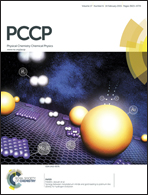A theoretical study of asymmetric electron transport through linearly aromatic molecules†
Abstract
Electron transport through a series of polyacene molecules connected via a π-conjugated bridge (an anthracene molecule) was investigated theoretically by using the nonequilibrium Green's function formalism combined with density functional theory. The results have shown that the asymmetric current–voltage characteristics can be achieved by tuning the position of a side π-bridge linked to the main conjugated backbone. The detailed analyses of the spatial distribution of molecular orbitals as well as the current density interpret how the location of π-bridge strongly affects the intramolecular electronic coupling. The rectification in the molecular junction arises from the localization of the molecular orbitals near the Fermi level and the asymmetric shift of molecule orbital energy levels under positive and negative bias. The rectification ratio decreases with increasing the length of the π-bridge which improves intramolecular electronic coupling between aromatic rings. Furthermore, the rectification properties of conjugated molecules are just slightly affected by the anchoring positions of thiol groups. These results demonstrated that the location and the length of π-bridge, which induce the asymmetric intramolecular coupling, play key roles in the rectification of the linearly aromatic molecules.


 Please wait while we load your content...
Please wait while we load your content...